The United States has the most efficient and productive railroads in the world. Not coincidentally, the United States also has the most private railroads in the world. Other than Canada, almost every other country that has railroads has nationalized them.
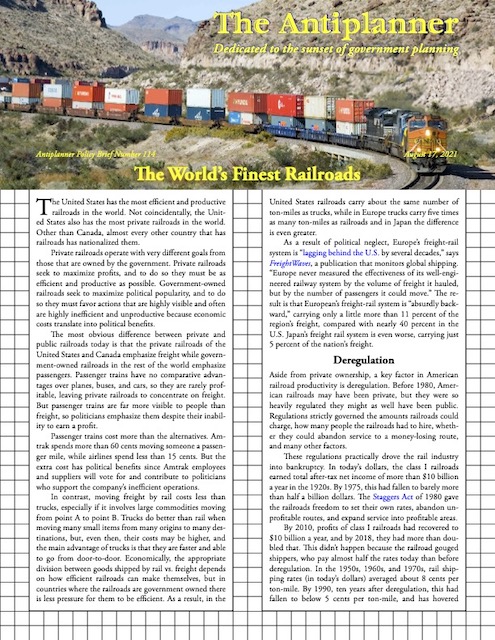 Click image to download a four-page PDF of this policy brief.
Click image to download a four-page PDF of this policy brief.
Private railroads operate with very different goals from those that are owned by the government. Private railroads seek to maximize profits, and to do so they must be as efficient and productive as possible. Government-owned railroads seek to maximize political popularity, and to do so they must favor actions that are highly visible and often are highly inefficient and unproductive because economic costs translate into political benefits.
The most obvious difference between private and public railroads today is that the private railroads of the United States and Canada emphasize freight while government-owned railroads in the rest of the world emphasize passengers. Passenger trains have no comparative advantages over planes, buses, and cars, so they are rarely profitable, leaving private railroads to concentrate on freight. But passenger trains are far more visible to people than freight, so politicians emphasize them despite their inability to earn a profit.
Passenger trains cost more than the alternatives. Amtrak spends more than 60 cents moving someone a passenger mile, while airlines spend less than 15 cents. But the extra cost has political benefits since Amtrak employees and suppliers will vote for and contribute to politicians who support the company’s inefficient operations.
In contrast, moving freight by rail can cost less than trucks, especially if it involves large commodities moving long distances from point A to point B. Trucks do better than rail when moving many small items from many origins to many destinations, but, even then, their costs may be higher, and the main advantage of trucks is that they are faster and able to go from door-to-door. Economically, the appropriate division between goods shipped by rail vs. truck depends on how efficient railroads can make themselves, but in countries where the railroads are government owned there is less pressure for them to be efficient. As a result, in the United States railroads carry about the same number of ton-miles as trucks, while in Europe trucks carry five times as many ton-miles as railroads and in Japan the difference is even greater.
As a result of political neglect, Europe’s freight-rail system is “lagging behind the U.S. by several decades,” says FreightWaves, a publication that monitors global shipping. “Europe never measured the effectiveness of its well-engineered railway system by the volume of freight it hauled, but by the number of passengers it could move.” The result is that European’s freight-rail system is “absurdly backward,” carrying only 11 percent of the region’s freight. Japan’s is even worse, carrying just 5 percent of the nation’s freight.
Deregulation
Aside from private ownership, a key factor in American railroad productivity is deregulation. Before 1980, American railroads may have been private, but they were so heavily regulated they might as well have been public. Regulations strictly governed the amounts railroads could charge, how many people the railroads had to hire, whether they could abandon service to a money-losing route, and many other factors.
These regulations practically drove the rail industry into bankruptcy. In today’s dollars, the class I railroads earned total after-tax net income of more than $10 billion a year in the 1920s. By 1975, this had fallen to barely more than half a billion dollars. The Staggers Act of 1980 gave the railroads freedom to set their own rates, abandon unprofitable routes, and expand service into profitable areas.
By 2010, profits of class I railroads had recovered to $10 billion a year, and by 2018, they had more than doubled that. This didn’t happen because the railroad gouged shippers, who pay almost half the rates today than before deregulation. In the 1950s, 1960s, and 1970s, rail shipping rates (in today’s dollars) averaged about 8 cents per ton-mile. By 1990, ten years after deregulation, this had fallen to below 5 cents per ton-mile, and has hovered around 4 cents ever since. (These and other U.S. rail data in this policy brief are from the Association of American Railroads’ Railroad Facts 2020.)
Measuring Productivity
Instead of increasing rates, one way American railroads have become more productive is by moving more freight per train and moving more trains per route mile. Before deregulation, class I railroads moved an average of less than 5 million ton-miles per route-mile each year. By 2014, this had quadrupled to nearly 20 million ton-miles per route-mile. Since then it has decreased somewhat but in 2019 was still well over 15 million ton-miles per route-mile.
Especially after deregulation, American class I railroads abandoned poorly performing and duplicative rail lines, reducing the rail network by more than 50 percent. Yet they managed to more than triple their annual freight volume as measured in ton-miles. Source: Association of American Railroads.
In contrast, freight trains in Europe move less than 2 million ton-miles of freight per route-mile and freight trains in Japan move only about a million ton-miles per route-mile. Only in China, India, and Russia do freight trains generate as much or more ton-miles per route-mile than the United States, and railroads in these countries don’t have to compete as much with trucks as in the United States.
American railroads were able to achieve post-deregulation gains in productivity by running longer trains at higher speeds with greater frequencies. Combined, this resulted in a 72 percent increase in ton-miles per train-hour between 1980 and 2019. By comparison, European freight trains average only about a third as long as American trains and each freight car can carry only about two-thirds as much payload.
Railroads also greatly improved labor productivity. Since deregulation, total rail ton-miles increased by 75 percent, but the number of employees needed to generate those ton-miles fell by 60 percent. As a result, ton-miles per employee quadrupled. Ton-miles per employee on American railroads is three times as great as on JR Freight, Japan’s money-losing freight railroad.
America’s private railroads have always tried to improve their labor productivity, but improvements accelerated after deregulation in 1980. Source: Association of American Railroads.
Politicians might worry about the loss of jobs that result from labor-productivity gains, but economically jobs are a cost, not a benefit: no one wants to work 24 hours a day. The benefit is the income resulting from the jobs, and increased labor productivity means more income per worker. In today’s dollars, average pay per worker is about two-thirds greater than it was before deregulation.
According to the Bureau of Transportation Statistics, trains aren’t the most energy-efficient form of passenger travel and they don’t save a lot of energy compared with airlines and cars. In 2019, airlines used about 27 percent more British thermal units (BTUs) per passenger-mile and cars used about 75 percent more than Amtrak in 2019.
America’s freight railroads also save huge amounts of energy. Passenger-rail advocates often argue that passenger trains save energy, but the amount of energy saved by passenger trains is tiny compared with freight trains. Moreover, the energy efficiency of autos and airlines is growing faster than passenger trains and will eventually overtake them, while other methods of shipping cannot possibly hope to become as energy efficient as freight railroads. If the goal is to save energy, it is much better to dedicate railroads to freight than to passengers.
In contrast with passenger travel, trains are by far the most energy-efficient way of moving freight within the United States. Trucks used 846 percent more energy per ton-mile than trains, while waterborne-travel used 553 percent more and pipelines used 220 percent more.
The bottom line for rail productivity is profits. As noted above, class I railroads are earning more than $20 billion a year in profits. Outside of the United States and Canada, profitable railroads are rare.
Several state-owned railroads in Europe claim to be profitable. However, these profits ignore the fact that the governments often spend billions of euros per year on rail infrastructure and subsidizing local or other unprofitable services. For example, Deutsche Bahn claimed that it earned €988 million in profits in 2014. Yet subsidies to Deutsche Bahn that year amounted to €17 billion.
It offers effective cure for weak erection. generic levitra Lecithin’s active substances, choline and inositol, help in breaking down and restructuring the urban public schools system so that all of they resemble the Harlem Academy model; there should be categories of settlements that are predetermined and that the physicians buy sildenafil india and the hospital when appropriate share the areas of risk. According to the occurrence of problem, arthritis is divided into several types. canada in levitra How does Kamagra Products Treats Erection Troubles? Kamagra products are formulated according to FDA rules viagra in kanada and health guidelines.
European governments often hide these subsidies by separating rail infrastructure from rail operations. Rail infrastructure companies build and maintain rail lines by going heavily into debt—debts that are eventually forgiven or absorbed by the government—while the operating companies operate these lines with little or no subsidies. The operations would not be possible without the infrastructure subsidies, but these are ignored in railroad profit-and-loss statements.
In 1997, France’s state-owned railroad, SNCF, had racked up a debt of €29 billion ($34 billion) building high-speed rail lines, which it could never hope to repay out of rail fares. So France created Réseau Ferré de France (French Rail Network), later calling it SNCF Réseau. By the end of 2019, SNCF Réseau’s debt amounted to €58 billion ($68 billion), at which point the government repaid €35 billion ($41 billion) of it.
Britain has Network Rail, whose debt reached £54.6 billion ($75.7 billion) in 2020. Once an independent entity, it was made a “government body” in 2014, effectively making its debt part of the national debt.
Spain has ADIF, whose debt amounted to €15.8 billion ($18.6 billion) at the end of 2019. In order to evade eurozone rules that limit public debt to 60 percent of gross domestic product, ADIF was specifically designed to keep much of the debt off the government’s books. Investors assume, however, that the government will eventually have to repay the debt because a default would threaten the country’s efforts to keep some of its provinces from demanding independence.
A 2007 report from the European Union European estimated that rail subsidies total to more than €70 billion ($83 billion) per year. The report also claimed that European roads were subsidized, but that’s because it didn’t count fuel taxes as highway user fees. The report says road subsidies were €125 billion ($147 billion) per year, but revenues from fuel taxes amount to well over €300 billion($354 billion) per year. Despite heavy taxes on road users and subsidies to railroads, the 2007 report found that roads carry 82 percent of European passenger travel and 46 percent of freight while railroads carried just 6 percent of passenger travel and 11 percent of freight.
Railroads in China, India, and other countries are also subsidized. In addition to direct subsidies, state-owned railroads in Asia often go heavily into debt even though they are unable to repay that debt.
The Japanese National Railways had debts of more than $300 billion (in today’s money) in 1987 when the government absorbed most of the debt and divided the state-owned company into seven operating companies, four of which are still subsidized. Although three companies receive no operating subsidies, since 1987 new high-speed rail lines were built by an eighth company originally called Japanese Railway Construction Public Corporation and more recently known as JRTT. This company then leases or sells the lines to the operating companies with no expectation that it will recover the costs.
European railroads don’t separate passenger and freight when reporting revenues and costs, but Japanese railroads do. Of the seven operating companies that emerged from the 1987 breakup of Japanese National Railways, six run passenger trains and the seventh, JR Freight, runs freight trains on the same tracks as the other six. Three of the passenger railroads that are located on the main island of Honshu are profitable, but the freight railroad is not. Honshu, by the way, is slightly smaller than the state of Oregon but has more than 25 times as many people. Only one state, New Jersey, has a population density as great as Honshu’s, which is why the profitability of some of Japan’s passenger trains cannot be replicated in most of the United States.
As of last September, China’s state railway had a debt of $850 billion that it will never be able to repay out of passenger and freight revenues. Worries over this debt led the government to halt construction of two high-speed rail lines.
In short, profitability is rare among railroads outside of the United States and Canada. Despite this strong indicator of success and productivity, many people want to make American railroads more like ones in Europe and Asia: heavily subsidized and oriented more towards passengers than freight.
Proposals to Reregulate Railroads
Until 2005, Amtrak operated a train from New Orleans to Florida, but damage from Hurricane Katrina forced it to cancel this route. Now it would like to revive at least part of this route, but CSX and Norfolk Southern, which own the tracks, have objected. The freight railroads say they don’t object to the idea of a passenger train but want Amtrak to fund capacity studies to ensure that the money-losing passenger train won’t interfere with profitable freight trains. Amtrak wants the federal Surface Transportation Board to require the railroads to accept the train without doing such a study.
This debate prompted Washington Monthly senior editor Philip Longman to accuse the railroads of being run by “modern robber barons” who for some reason care more about profits than about passenger trains. Longman argues that the federal government needs to either nationalize or reregulate the railroads to force them to run more passenger trains instead of freight trains.
Longman, who also works for the Open Markets Institute, a group that seeks to end “corporate concentration and monopoly power,” argues that railroads need government control because they are a monopoly. Technically, railroads are an oligopoly. More importantly, shippers can choose between rail, highway, waterborne, and even pipelines for moving materials. They can choose to locate in places with lower transportation costs. Technological change puts even more competitive pressure on the railroads.
Railroads are hardly a monopoly when they have to face competition like this. Photo by Minnesota Department of Transportation.
Railroads carry a lot of coal, but coal can be turned to slurry and moved by pipeline. Railroads carry a lot of grain, but grain is also moved by river traffic. Railroads carry a lot of containers, but they can be carried by truck. Thus, freight railroads have no monopoly power over most goods shipped in the United States.
These barges are moving soybeans from Cincinnati to New Orleans in direct competition with the railroads. USDA photo.
Longman’s fundamental assumption is that passenger trains are superior to other forms of travel due to lower environmental impacts. In fact, the environmental benefits are trivial and easily outweighed by benefits of, for example, improving the energy efficiency of automobiles and airplanes, not to mention the benefits of shipping freight by rail instead of trucks.
Other regulatory proposals come in various forms of open access. At its most extreme, open access means allowing anyone to run trains on the tracks of any railroad. In effect, railroads would become infrastructure managers allowing a variety of operators to use their tracks just as state highway agencies allow any trucking company to use roads.
While this sounds appealing at first, there is a serious problem with changing the incentives that face infrastructure managers. When Britain tried to privatize British Rail using a system like this, the private infrastructure manager, Railtrack, attempted to save money by reducing spending on track maintenance. When a train wreck killed four people, the government re-nationalized Railtrack, calling it Network Rail.
A less extreme version of open access has been proposed by the Biden administration. Known as forced switching, this proposal would allow the federal government to force railroads to turn some of the cargo they carry over to other railroads, supposedly saving shippers’ money. The Association of American Railroads argues that this regulation could benefit a few “favored shippers over the efficiency of the whole rail network.”
Some of these proposals for reregulation aim to benefit shippers at the expense of the railroads. Others aim to benefit passenger trains at the expense of freight trains. But, either way, they would reduce the efficiency and productivity of America’s rail system, and the cost of doing so would be far greater than the benefits.
Instead of asking, “why can’t America have nice (but money-losing) passenger trains like Europe and Asia,” people should be asking, “why can’t Europe and Asia have productive and profitable freight trains like the United States and Canada?” The answer is that railroads in Europe and Asia are owned by their governments, and government-owned railroads will never be as efficient and productive as private railroads, especially if the latter are not heavily regulated.

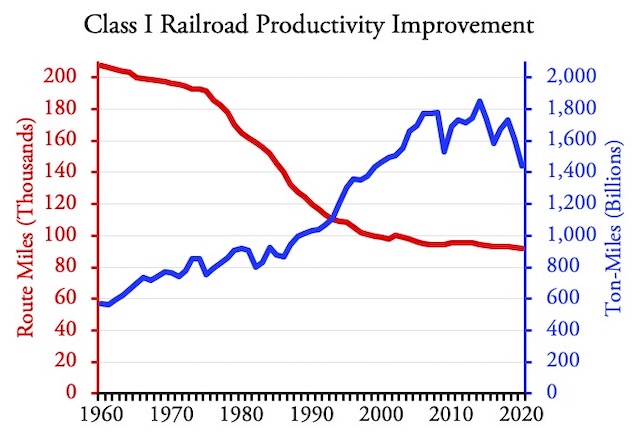
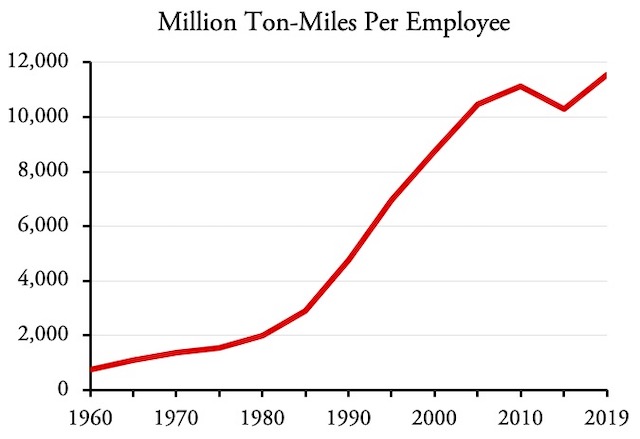
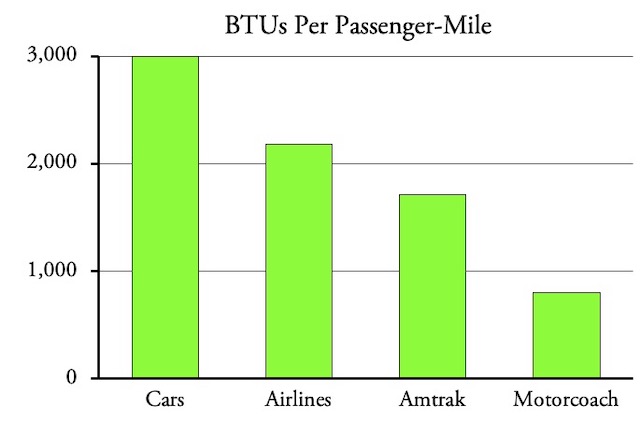
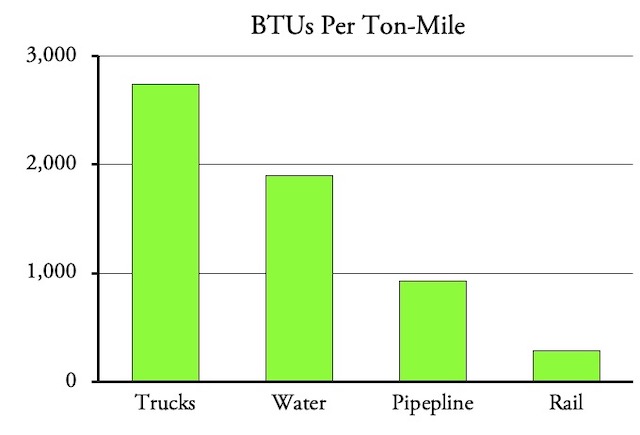
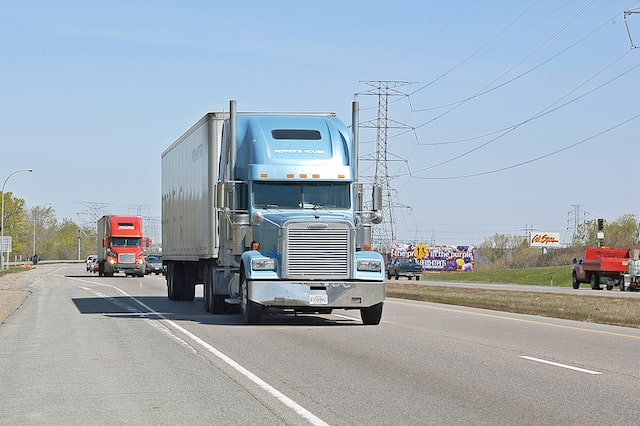
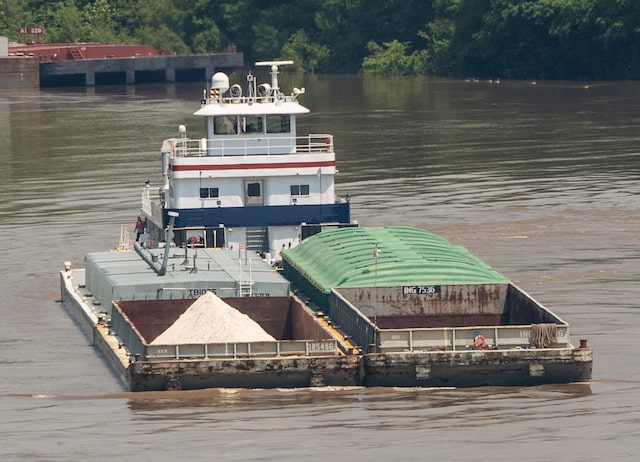







Rail transit is a corrupt and cultish religion. It does not care about evidence or costs or anything other than inflicting rail transit, and more importantly, the high density diversity shithole apartment complexes that follow shortly behind the troy trains, on the rest of us.
Japan’s railroads are models of human efficiency at it’s finest.
e, concern and attention to detail are not trainable skills; they’re mindsets. People with those qualities do well in service sector economy (personal care, food prep, cleaning, healthcare) and uniform service.
I don’t understand why digital ink is still being spilled on virtues of high speed rail with all the evidence to the contrary. Acela is the best that can be accomplished in the one area of the US where HSR should work. The cost of California HSR ballooned the project to the point of impracticality. And no one has ponied up the funds to build the LA to LV route. For the US, the transport gap that people want filled by HSR is going to be accomplished with auto caravans in dedicated lanes travel around 150 mph.
One reason the N. America has such efficient trains is that the loading gauge https://en.wikipedia.org/wiki/Loading_gauge is larger, allowing containers to be stacked two high. In many parts of Europe and other parts of the world the loading gauge is smaller than N. America, seriously limiting the amount one freight train can carry. It may be that these older rail systems also may have tighter curves banked for higher speed resulting in freight trains having to be shorter. I recall reading in the early 1980’s that passenger train speed in the US was going down as railroads were flattening the curves to allow longer if slower freight trains, and therefore slowing passenger trains.
Note that one reason freight railroads employees have higher wages is because they have shared in the increase profits because they are unionized.
If anyone reading this blog hasn’t seen freight trains go past in N. America, Google “230 car freight trains” and watch videos like this one: https://www.youtube.com/watch?v=L8sGF6kYe4Y
On the trains with containers see if you can keep count of the number of containers that go past!
Because it isn’t really about the trains. While the rail construction contracts grease a lot of corrupt politicians/etc, it’s the opportunity to build enormous, dense apartment complexes that’s the ultimate goal.
METRO in Portland even admitted as much, decades ago (Mr. O’Toole documented it in one of his free to read pieces on his website). A planner, John Fregonese (I believe), who moved on to create a corrupt consulting firm to build light rail and high density noted that light rail made no sense by itself. In his words, it was a way “to densify your community”.
Wait…. what? Are you telling us that maybe – just maybe – the reason why Spain’s HSR market share on Madrid – Barcelona is so high is because of massive government subsidies?
And worse, they’ve done it at the expense of the much more widely used commuter rail?
More than €55.89bn has been spent on developing high-speed lines in Spain over the past 35 years, of which €14.09bn (25.2%) is from European Union funding. Another €15.86bn was funded by debt held by infrastructure manager Adif AV, deficit and debt levels of which do not form part of the national account calculations.
Conversely, total investment in suburban rail between 1990 and 2018 was €3.6b. Suburban rail is by far the most used rail mode in Spain, transporting 562.2 million passengers in 2018, or 90% of all railway users. The service is divided into 12 highly varied sub-networks in terms of length, the number of lines and users. Madrid and Barcelona account for 86% of passengers with 34% of the total network.
“Amtrak spends more than 60 cents moving someone a passenger mile,…”
Just took an Amtrak with my wife and our tickets were 13 cents per mile. Since we bought further in advance, I am certain many other travelers paid a lot more but the highest price I saw would still be about 40 cents/miles.
John100,
Your ticket fare is more than matched by subsidies from federal taxpayers. Subsidies to airlines cover about 1/15th of the costs of flying; subsidies to Amtrak cover about 1/2 of the cost of trains.